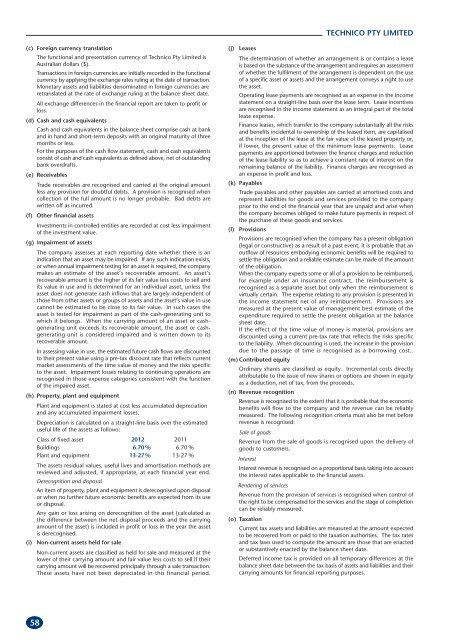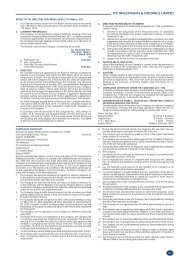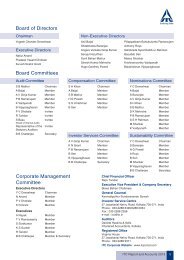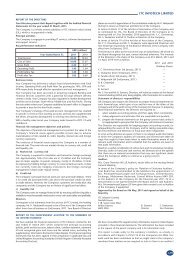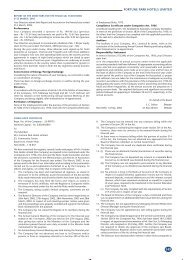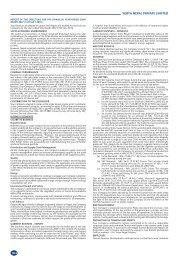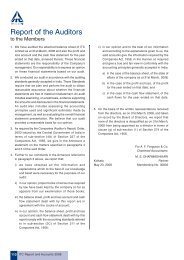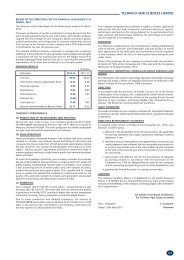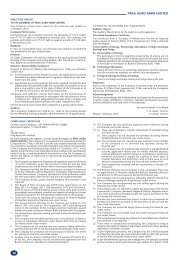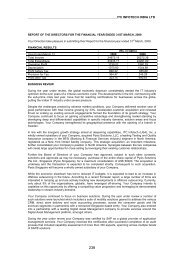SUBSIDIARY COMPANIES - ITC Ltd
SUBSIDIARY COMPANIES - ITC Ltd
SUBSIDIARY COMPANIES - ITC Ltd
Create successful ePaper yourself
Turn your PDF publications into a flip-book with our unique Google optimized e-Paper software.
(c) Foreign currency translation<br />
The functional and presentation currency of Technico Pty Limited is<br />
Australian dollars ($).<br />
Transactions in foreign currencies are initially recorded in the functional<br />
currency by applying the exchange rates ruling at the date of transaction.<br />
Monetary assets and liabilities denominated in foreign currencies are<br />
retranslated at the rate of exchange ruling at the balance sheet date.<br />
All exchange differences in the financial report are taken to profit or<br />
loss.<br />
(d) Cash and cash equivalents<br />
Cash and cash equivalents in the balance sheet comprise cash at bank<br />
and in hand and short-term deposits with an original maturity of three<br />
months or less.<br />
For the purposes of the cash flow statement, cash and cash equivalents<br />
consist of cash and cash equivalents as defined above, net of outstanding<br />
bank overdrafts.<br />
(e) Receivables<br />
Trade receivables are recognised and carried at the original amount<br />
less any provision for doubtful debts. A provision is recognised when<br />
collection of the full amount is no longer probable. Bad debts are<br />
written off as incurred.<br />
(f) Other financial assets<br />
Investments in controlled entities are recorded at cost less impairment<br />
of the investment value.<br />
(g) Impairment of assets<br />
The company assesses at each reporting date whether there is an<br />
indication that an asset may be impaired. If any such indication exists,<br />
or when annual impairment testing for an asset is required, the company<br />
makes an estimate of the asset’s recoverable amount. An asset’s<br />
recoverable amount is the higher of its fair value less costs to sell and<br />
its value in use and is determined for an individual asset, unless the<br />
asset does not generate cash inflows that are largely independent of<br />
those from other assets or groups of assets and the asset’s value in use<br />
cannot be estimated to be close to its fair value. In such cases the<br />
asset is tested for impairment as part of the cash-generating unit to<br />
which it belongs. When the carrying amount of an asset or cashgenerating<br />
unit exceeds its recoverable amount, the asset or cashgenerating<br />
unit is considered impaired and is written down to its<br />
recoverable amount.<br />
In assessing value in use, the estimated future cash flows are discounted<br />
to their present value using a pre-tax discount rate that reflects current<br />
market assessments of the time value of money and the risks specific<br />
to the asset. Impairment losses relating to continuing operations are<br />
recognised in those expense categories consistent with the function<br />
of the impaired asset.<br />
(h) Property, plant and equipment<br />
Plant and equipment is stated at cost less accumulated depreciation<br />
and any accumulated impairment losses.<br />
Depreciation is calculated on a straight-line basis over the estimated<br />
useful life of the assets as follows:<br />
Class of fixed asset 2012 2011<br />
Buildings 6.70 % 6.70 %<br />
Plant and equipment 13-27 % 13-27 %<br />
The assets residual values, useful lives and amortisation methods are<br />
reviewed and adjusted, if appropriate, at each financial year end.<br />
Derecognition and disposal<br />
An item of property, plant and equipment is derecognised upon disposal<br />
or when no further future economic benefits are expected from its use<br />
or disposal.<br />
Any gain or loss arising on derecognition of the asset (calculated as<br />
the difference between the net disposal proceeds and the carrying<br />
amount of the asset) is included in profit or loss in the year the asset<br />
is derecognised.<br />
(i) Non-current assets held for sale<br />
Non-current assets are classified as held for sale and measured at the<br />
lower of their carrying amount and fair value less costs to sell if their<br />
carrying amount will be recovered principally through a sale transaction.<br />
These assets have not been depreciated in this financial period.<br />
58<br />
TECHNICO PTY LIMITED<br />
(j) Leases<br />
The determination of whether an arrangement is or contains a lease<br />
is based on the substance of the arrangement and requires an assessment<br />
of whether the fulfilment of the arrangement is dependent on the use<br />
of a specific asset or assets and the arrangement conveys a right to use<br />
the asset.<br />
Operating lease payments are recognised as an expense in the income<br />
statement on a straight-line basis over the lease term. Lease incentives<br />
are recognised in the income statement as an integral part of the total<br />
lease expense.<br />
Finance leases, which transfer to the company substantially all the risks<br />
and benefits incidental to ownership of the leased item, are capitalised<br />
at the inception of the lease at the fair value of the leased property or,<br />
if lower, the present value of the minimum lease payments. Lease<br />
payments are apportioned between the finance charges and reduction<br />
of the lease liability so as to achieve a constant rate of interest on the<br />
remaining balance of the liability. Finance charges are recognised as<br />
an expense in profit and loss.<br />
(k) Payables<br />
Trade payables and other payables are carried at amortised costs and<br />
represent liabilities for goods and services provided to the company<br />
prior to the end of the financial year that are unpaid and arise when<br />
the company becomes obliged to make future payments in respect of<br />
the purchase of these goods and services.<br />
(l) Provisions<br />
Provisions are recognised when the company has a present obligation<br />
(legal or constructive) as a result of a past event, it is probable that an<br />
outflow of resources embodying economic benefits will be required to<br />
settle the obligation and a reliable estimate can be made of the amount<br />
of the obligation.<br />
When the company expects some or all of a provision to be reimbursed,<br />
for example under an insurance contract, the reimbursement is<br />
recognised as a separate asset but only when the reimbursement is<br />
virtually certain. The expense relating to any provision is presented in<br />
the income statement net of any reimbursement. Provisions are<br />
measured at the present value of management best estimate of the<br />
expenditure required to settle the present obligation at the balance<br />
sheet date.<br />
If the effect of the time value of money is material, provisions are<br />
discounted using a current pre-tax rate that reflects the risks specific<br />
to the liability. When discounting is used, the increase in the provision<br />
due to the passage of time is recognised as a borrowing cost..<br />
(m) Contributed equity<br />
Ordinary shares are classified as equity. Incremental costs directly<br />
attributable to the issue of new shares or options are shown in equity<br />
as a deduction, net of tax, from the proceeds.<br />
(n) Revenue recognition<br />
Revenue is recognised to the extent that it is probable that the economic<br />
benefits will flow to the company and the revenue can be reliably<br />
measured. The following recognition criteria must also be met before<br />
revenue is recognised:<br />
Sale of goods<br />
Revenue from the sale of goods is recognised upon the delivery of<br />
goods to customers.<br />
Interest<br />
Interest revenue is recognised on a proportional basis taking into account<br />
the interest rates applicable to the financial assets.<br />
Rendering of services<br />
Revenue from the provision of services is recognised when control of<br />
the right to be compensated for the services and the stage of completion<br />
can be reliably measured.<br />
(o) Taxation<br />
Current tax assets and liabilities are measured at the amount expected<br />
to be recovered from or paid to the taxation authorities. The tax rates<br />
and tax laws used to compute the amount are those that are enacted<br />
or substantively enacted by the balance sheet date.<br />
Deferred income tax is provided on all temporary differences at the<br />
balance sheet date between the tax basis of assets and liabilities and their<br />
carrying amounts for financial reporting purposes.


